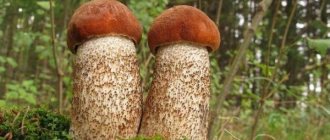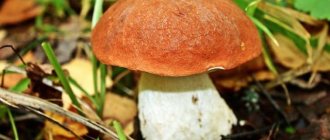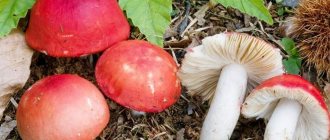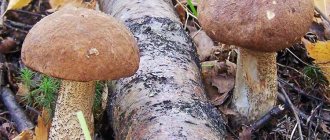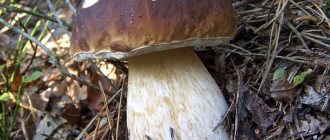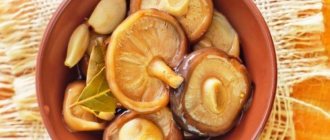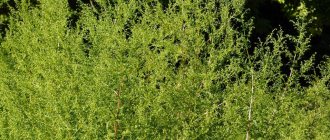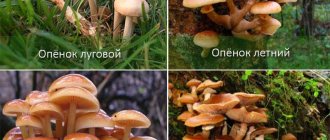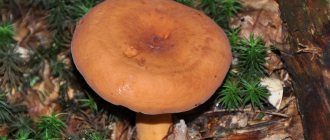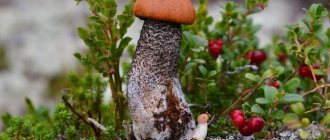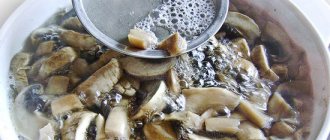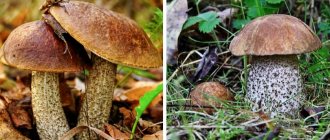Brief description of edible mushroom
Boletus or White Aspen is classified as a member of the genus Leccinum, of the Boletaceae family. It bears the Latin name Leccinum percandidum, there are also several synonyms - Boletus percandidus, Leccinum aurantiacum, Boletus versipellis and Krombholzia rufescens.
The cap grows in diameter up to 15 cm, less often reaches 25 cm. It has a cushion-shaped shape, the color is white with a pink tint, brown or blue-green. As it ages, it acquires yellow tones. The skin is dry, bare, felty.
The hymenophore or lower part of the cap consists of finely porous tubes, white or yellow in color; older specimens become gray or brownish in color. The spores are brown and ocher.
The pulp is white, quite dense, blue-green closer to the base of the stem. When cut, it quickly turns blue, then black, and acquires a purple color.
The leg is tall, can reach 15 cm, and in diameter no more than 4 cm, its shape thickens downwards and resembles a club. The color is white, covered with scales, which over time become gray or brownish and have a fibrous structure.
This is such a rare guest in the mushroom picker’s basket that it is listed in the Red Book of Russia, as well as most regional ones where it grows. Prohibited for collection.
A little history
The first to talk about white boletus was the Soviet scientist, mycologist Boris Pavlovich Vasilkov, who studied mushrooms of the Arctic and other regions. His Scottish colleague Roy Watling helped with the systematization in 1960.
Description of appearance
The white boletus is medium in size and looks similar to the boletus. Its cap is white, with a tubular hymenophore and grows to a maximum diameter of 20 cm, but the minimum can reach only 5 cm. The young mushroom is distinguished by a hemispherical shape of the cap, which gradually becomes convex, with outstretched sides. The color is white or with a grayish tint. The surface is dry, the structure (to the touch) resembles velvet. The spore-bearing tubes are white with a gray tint; if you touch them, they will darken. The pores also have a grayish tint.
Irina Selyutina (Biologist):
The color of the white boletus cap resembles the marsh boletus. But there are differences in the internal shape of the cap: in the boletus it is concave, in contrast to the straight or slightly hanging down of the boletus.
Despite all the similarities with boletus, boletus has its own differences. Its tall leg is up to 4 cm in diameter, thickened at the bottom, has a strong structure, white color, and has white lagging scales. They darken with age. The pulp at the base has a blue or green tint. The inside is dense, white, when cut it acquires a lilac-gray tint, and over time it turns black when exposed to air. The mushroom tastes and smells pleasant, just like boletus.
Time and place of fruiting
It prefers pine forests mixed with spruce or other trees; in dry times it hides in damp places in aspen forests. Found in birch forests. Fruiting lasts from June to September.
It is quite rare, but sometimes large families of white boletus can be found. On the territory of Russia it is found in the Murmansk and Penza regions, as well as in the republics of Mari El, Komi and Chuvashia. Known in the Moscow and Leningrad regions, as well as in eastern Siberia, in the Arkhangelsk region. This mushroom is also found in the southwestern territory of Lake Baikal and the territories of Khanty-Mansi Autonomous Okrug and Yamalo-Nenets Autonomous Okrug.
Finds of white boletus are known in Estonia, Belarus and Latvia, as well as in western Europe and North America.
Video
Preparation and storage
In order to preserve white boletuses, they are salted, pickled, frozen and dried. It is recommended to use more mature specimens for drying. Mushrooms should be peeled, but not washed; you can use a brush. Then they should be inspected for the absence of worms and rot, cut into equal pieces, and laid out in one layer. It is necessary to ensure that the drying process proceeds evenly.
Can be dried in the oven at 50 degrees with the door open. After 4-5 hours you can get aromatic dried mushrooms. Completely cooled mushrooms are stored in a closed container in a dark, cool place. To prepare them, they are soaked in water, washed, boiled and used to make soups, sauces, or fried with potatoes.
To freeze, mushrooms should be cleaned in the same way and boiled for 10 minutes. Then the boletus mushrooms need to be completely cooled, spread out in one layer and placed in the freezer. This way mushrooms are stored for 3-6 months. You can use this preparation like regular boiled mushrooms for preparing various dishes.
Growing at home and in the country
White boletus is a tasty, edible mushroom that gets along well in a prepared garden plot. To plant it, you will need to purchase mycelium, which is enough for 3 square meters. m. under one tree or bush. Planting process:
- The area at the roots of the plant is dug up and a depression of up to 15 cm is created.
- The mycelium is evenly distributed over the entire area of the pit.
- The top needs to be covered with garden soil mixed with humus in equal proportions.
- Cover with the remaining soil from digging a hole.
Any trees are suitable for planting; the mycelium will take root regardless of the time of year (in the southern regions it can be planted in winter). Water with a regular garden watering can; the planted area will need 30 liters of water.
The first harvest can be observed in autumn or spring, but not earlier than 5 months later. After planting, most often the first fruits can only be harvested the next year. From a planted plot it is possible to collect about 1.5 kg in the first year and up to 14 in the next. Mushrooms will delight as long as the tree lives.
Are there white boletuses?
Boletuses are different types of mushrooms that belong to the genus Leccinum. They are distinguished by an orange cap and dense flesh. The leg is usually thick, widening towards the base. When cut, the flesh acquires a bluish tint.
Most mushroom pickers are familiar with the red boletus. This is a mushroom with a cap up to 15 cm in size, hemispherical or convex in shape. The color is red, orange or brownish. The leg is up to 5 cm thick and reaches 15 cm in length. The flesh is dense, elastic, and white. After cutting it becomes bluish and even black. The variety is valued for its taste. It is used for frying, boiling, pickling and salting.
White boletuses are often found in forests. Their cap is not brightly colored. Its color remains milky white, as does the leg. These mushrooms have a good taste and are suitable for consumption. They are also popularly known as obabki.
False doubles
Science does not know any false species of boletus, but many inexperienced mushroom pickers can confuse the tasty edible fruit with bitterling. It is very easy to distinguish it from white aspen - it is yellow. The surface of the cap and the stem itself have beige shades, while white boletus can have grayish shades even at an old age. The boletus turns blue when cut, and the bitterling becomes pink or reddish.
Gorchak
What is the difference between porcini mushroom and boletus?
The porcini mushroom is easy to distinguish from the white boletus, because its cap will be light brown in color, and sometimes with a reddish tint. The pulp does not change color when cut, unlike aspen, and the stem is slightly thicker. The boletus has a special mesh pattern on the stem, by which it is easy to distinguish.
In terms of taste, boletus is somewhat inferior to boletus, and its flesh is a little harder. The porcini mushroom also has dense flesh, but it is juicy and meaty, which cannot be said about the boletus.
Porcini
How to distinguish false white boletuses
White boletuses have a false twin. This is a mushroom that is similar to them in appearance. This includes the gall fungus, which is also called false boletus. This name is associated with the bitter taste of its pulp, which only intensifies during heat treatment.
The gall mushroom has a cap measuring from 4 to 15 cm. Its shape is hemispherical and becomes prostrate over time. The surface is dry, velvety, and becomes sticky after rains. The color is yellow with a brown, gray or brown undertone. The leg is from 3 to 13 cm high. Its shape is cylindrical, often there is a thickening at the base.
False boletus is distinguished from the real one by the color of the pulp. In the gall fungus it has a pink tint. Also, the false double has a yellow or pink mesh on its leg. It is absent in the white species. Also pay attention to the color of the cap. The gall fungus has a more pronounced color.
Boletuses have characteristic features, so they are difficult to confuse with poisonous mushrooms. Varieties may differ in cap size and color. However, they are all edible and do not pose a threat to human health.
Evaluation of taste qualities, medicinal properties, benefits and possible harm
White boletus is an edible fruit that belongs to the second category. It is believed that it is better to pickle young fruiting bodies, and it is preferable to fry or dry more mature specimens. This mushroom is dried, frozen, salted, and it also goes well with other relatives in one dish.
Among the beneficial properties are:
- ability to purify blood;
- removal of harmful substances from the body, it works as an absorbent;
- ability to lower cholesterol;
- restoration of immunity;
- sedative properties;
- tissue regeneration;
- restoration of intestinal microflora.
In addition, boletus helps in the treatment of cancer.
Attention! Mushrooms are prohibited for children under 3 years of age, pregnant and lactating women. Use with caution if you have diseases of the stomach, liver and intestines. Individual intolerance and gout may be prohibited.
A large number of tinctures are prepared from white boletus; it is especially popular in folk medicine. Using the product will help cope with the following diseases:
- atherosclerosis;
- oncology;
- dysbacteriosis;
- depression, nervous tension;
- restoration of immunity;
- anemia, improves complexion.
To prepare the tincture you will need:
- white boletus caps;
- vodka or Cahors;
- glass jar.
The parts of the mushroom are cleaned and washed, cut into small pieces, placed in a jar, then filled with the selected alcohol composition. The sealed container is placed in a dark place for 15 days. After this, the resulting mass should be filtered and drunk 3 tbsp. l. in a day. The course of treatment is up to 3 months.
Contraindications
Whatever the useful product and whatever gastronomic qualities it has, before use you should always take into account not only the beneficial properties of white boletus and the contraindications that it has. It is recommended to use the mushroom with caution in case of diseases:
- stomach,
- liver and gallbladder,
- kidney,
- intestines.
And in the acute stage, it is better to completely exclude dishes with white aspen from the diet. In any case, it would be a good idea to have a preliminary consultation with a doctor you trust.
In addition, white boletus is contraindicated:
- having an allergy to mushrooms,
- pregnancy,
- lactation period.
If you are prone to allergic reactions, you need to be careful and include white boletus in your diet gradually, starting with a small amount. Individual intolerance is also possible.
Since mushrooms are a rather difficult product for the digestive system, they are not recommended for children under 7 years of age.
Literature:
T.A. Ilyina. Mushrooms. Atlas-determinant.
A.P. Umeltsev. Encyclopedia of mushroom picker.
Lagutina T.V. The complete encyclopedia of mushrooms.
Preparation
The broth from white boletus is compared to meat. It is worth considering that during the cooking process the fruits will shrink several times due to the large amount of water they contain. Boletus does not change color only when marinated; in other cases it darkens. A solution of citric acid helps to get rid of too dark a shade of fruits and prevent them from shrinking during cooking. To prepare, dissolve 0.5 g of citric acid in 1 liter of water. Mushrooms should be cut more finely, then they will be better digested.
Primary processing
Before you start cooking boletus mushrooms, they should be cleared of forest debris and washed. If you decide to eat not only the caps, but also the legs, then you need to scrape off all the scales from them.
Important! You cannot leave mushrooms in water for a long time; they will become loose and unsuitable for food.
Cooking
In order to enjoy boiled white boletuses, simply dip the peeled fruits into boiling salted water and cook for 20 minutes. When the mass sinks to the bottom, they are ready, you can remove them with a slotted spoon, and the broth is perfect for mushroom soup.
Pickling
Boletus mushrooms can be prepared in marinade in different ways, but there is one fairly simple method that everyone will like. To do this you will need:
- mushrooms – 1 kg;
- water – 0.5 l;
- salt – 1 tbsp. l.;
- vinegar – 70 ml;
- sugar – 1 tsp.
Cooking process:
- Pour water into a saucepan, add salt, vinegar and mushrooms, bring to a boil.
- Reduce heat and simmer for 30 minutes, skim off foam with a slotted spoon.
- As soon as the foam stops appearing, add sugar.
- If the fruits have sunk to the bottom and the broth has become transparent, it means they are ready and can be removed from the heat.
- Cool the mixture, then put the mushrooms in jars and pour in the marinade.
These boletus mushrooms are stored in a cool, dark place or on the bottom shelf of the refrigerator; after 30 days you can try them.
Freezing
For longer storage of mushrooms, freezing is often used. To do this, the boiled fruits are cooled. Allow excess liquid to drain and place in prepared containers or bags. They can be stored in the freezer all winter, and you don’t need to defrost them to cook, just put them in a saucepan or frying pan. For this reason, it is better to cut them into convenient pieces in advance and distribute them in portions.
Frying
Delicious mushrooms with boiled potatoes is one of the most popular dishes, for the preparation of which you will need:
- fruits – 2 kg;
- onion – 300 g;
- vegetable oil – 100 ml;
- salt, pepper - to taste.
Cooking process:
- Mushrooms are cleaned of debris, scales are removed from the stem or removed completely, and washed under running water.
- Boletuses, cut into pieces, are dipped in water, boiled for 15 minutes, and salted.
- After the fruits are cooked, they are placed in a frying pan with heated oil.
- In a separate frying pan, fry the onion, cut into half rings, until golden brown.
- After 15 minutes of frying the mushrooms, ready-made onions are added to them.
- After 5 minutes you can remove from heat.
Fried boletus mushrooms are served as a separate dish or with a side dish.
Pickling
To pickle aspen mushrooms you will need:
- mushrooms – 3 kg;
- salt – 6 tbsp. l.;
- peppercorns – 20 pcs.;
- laurel leaves – 4 pcs.;
- onion - 1 pc.
Cooking process:
- Prepared mushrooms are cut into small pieces. It is best to salt the caps separately from the legs, but when there are few of them, you can do it together.
- Place the fruits in a saucepan, add water, add salt and whole onions, boil for 10 minutes, drain and let drain.
- Pour 2.5 liters of water, boil, then add all the ingredients with the fruits together. Cook for 40 minutes.
- After the boletuses have sunk to the bottom, they can be placed in jars.
- Pour brine 1.5 cm higher than the level of the mushrooms.
Close the jars with lids and put them in a cool, dark place; you can eat them no earlier than a month later.
Drying
More mature specimens are often used for drying. The fruits are cleaned but not washed; you can use a soft brush. Then you need to inspect them for the absence of worms and rot, and if found, remove everything. Mushrooms should be cut into equal parts so that drying occurs evenly.
It is most convenient to dry in the oven at a temperature of 50 degrees. The door always remains open to allow moisture to escape. After 4-5 hours, you can take a break, take out the baking sheet and let it “breathe” a little. After 20 minutes put it back.
Important! During the drying process, you should constantly turn the tray with mushrooms.
When pressed, dried boletuses should not release moisture or crumble into dust.
Canning for the winter in jars
Mushrooms can be canned; this method will help preserve them for a longer time; the following products will be required:
- boletus - 2 kg;
- salt – 4 tbsp. l.;
- laurel leaves – 2 pcs.;
- black peppercorns – 7 pcs.;
- cloves -6 buds;
- dill - 2 umbrellas;
- blackcurrant or horseradish leaves - 5 pcs.
Cooking process:
- Chop the peeled mushrooms, put them in boiling water, add salt, and cook for 30 minutes. Periodically skim off any foam that forms.
- When the foam stops appearing, add all the spices and seasonings.
- As soon as the fruits have settled and the broth has become clear, you can turn off the heat.
- Place mushrooms in sterilized jars and fill with brine 2 cm higher. Roll up the lids.
Should be stored in a cool, dark place, after 50 days you can eat.
Aspen soup recipe
To prepare mushroom soup you will need:
- boletus - 0.5 kg;
- water – 2 l;
- onion -150 g;
- carrots – 150 g;
- potatoes – 300 g;
- vegetable oil - 1 tbsp. l.;
- small pasta - 1.5 tbsp. l.;
- bay leaf, peppercorns, salt - to taste.
Cooking process:
- Cut the washed mushrooms into small pieces and boil in salted water for 40 minutes. Drain in a colander.
- Add chopped potatoes to the resulting broth.
- At this time, sauté finely chopped onion in a frying pan, add grated carrots to it, lightly fry and add mushrooms to them, fry for 10 minutes.
- Add pasta and frying, as well as pepper and bay leaves to the broth with potatoes. After 5 minutes, turn off the heat.
This soup is best served with sour cream and herbs.
How to process
White boletus is a mushroom that requires certain preliminary preparation before the main culinary processing.
- The mushrooms are carefully sorted, discarding rotten and wormy specimens.
- Using a sponge, clean off dirt, soil, forest debris, etc.
- Rinse thoroughly in running water. White boletus can be soaked, but not for long, as it tends to absorb water, and if soaked for a long time, the pulp becomes too soft, loose and unsuitable for food.
- Then you need to use a knife to carefully scrape off the scales from the legs.
- The next mandatory step is boiling (of course, this is skipped when drying). There is no need to pour out the white boletus decoction; you can use it to make a delicious mushroom soup.
- The disadvantages of white boletus include the fact that after any processing, with the exception of pickling, it darkens, which is not a sign of spoilage. Its taste properties remain unchanged. This can be avoided by first soaking the prepared mushrooms in a 0.5% (0.5 g per 1 liter of water) citric acid solution.
Interesting Facts
The most unique mushroom is the white boletus. It cannot be confused with any other, it is unique in its composition and outwardly differs significantly from all other representatives of the forest kingdom.
Boletus is one of the leaders in the content of vitamin B2 and PP. It contains approximately 0.4 mg of the first, and up to 10 mg of the second.
Tasty and in many ways healthy white boletuses are protected by the Red Book of Russia, but anyone can grow this fruit in their own plot and delight themselves and their loved ones with delicious foods. It is easy and simple to assemble and easy to prepare.
Chemical composition
Nutritional value depends on the chemical composition of white boletus. The plant contains mono- and disaccharides, amino acids, including essential, unsaturated fatty acids, etc. Vitamins A, E, C, B1, B2 (0.4 mg), PP (up to 10 mg) are also present.
Macro- and microelements in the composition of white boletus make up about 1.5% and are represented by the following: potassium (404 mg), phosphorus (90 mg), magnesium (16 mg), sodium (6 mg), calcium (3 mg), iron ( 0.3 mg), potassium, etc.
Important! The information presented in the material is for informational purposes only. Before use, be sure to consult a specialist.
In cooking
In terms of nutritional properties and richness, broth based on these mushrooms is comparable to meat broth. Edible mushrooms are comparable to meat. They taste tender and pleasant. Any methods of processing them are appropriate: they are boiled, fried, pickled, salted and dried. In the recipe for red borscht there is a version with mushrooms, it goes like a Lenten one.
The mushroom consists mostly of water, so during the cooking process its size decreases several times. It can also darken, but if you marinate it, it will remain the same. To solve the problem of mushrooms shrinking and darkening, they are soaked in a citric acid solution for a couple of hours. The finer you chop the mushrooms, the better they will be digested.
Boletus is nutritious and contains beneficial microelements in its base.
Description of the boletus mushroom
I admit, it was somewhat unexpected for me when I became convinced that not everyone is familiar with the boletus mushroom. I’ve known it since childhood... The boletus has several signs that prevent it from being confused with other mushrooms.
The color of the cap is very important, but far from the only feature that distinguishes this mushroom. In addition, the redhead is quite variable in color - it is, of course, red... But not always! There are boletuses with a brown cap, reminiscent of porcini mushrooms. There are almost orange ones. And there are even white aspen trees! (Although this is, most likely, a different, albeit similar, species of mushroom, rare and listed in the Red Book of Russia. I have encountered similar mushrooms, although it’s been a long time since their cap is almost white).
The boletus belongs to the genus Obabok of the Boletaceae family. Like all monkeys, the redhead's leg appears to be covered with dark-colored scales, which is clearly visible. The boletus also has a similar decoration on its legs.
When scrapped or cut, the boletus mushroom immediately begins to darken. At first the cut turns blue, and then can become almost black. This is sometimes scary for novice mushroom pickers. It's just in vain! On the contrary, this is another sign confirming that you have found a red mushroom. And it darkens as a result of the oxidation in air of some substances characteristic of boletus.
True, it’s not just boletuses that turn blue. Therefore, a mushroom can only be judged by its entire set of characteristics. So, if you find a mushroom: - with a red, reddish or brown color; - with a tubular layer on the underside of the cap, usually light gray in color; - with a stalk, against a light background of which dark “scales” stand out; - after cutting, first blue , and after a few minutes turns black; - similar in appearance to one of the mushrooms in the photo of this article on my blog, then it is almost certainly a boletus mushroom.
Young boletuses are quite peculiar (unfortunately, there are no photos yet). The cap of this mushroom at a young age is very small, and on a rather large stem it looks like a thimble placed on a finger. (Or like the red cap on a gnome's head!)
The mushroom, both young and adult, is very dense. But if the red mushroom you found is soft to the touch, then it is better not to take it. It is already overripe, and even if it is not wormy, it is not suitable for food!
Any old mushrooms have already accumulated quite a lot of harmful substances, and you should not take them!
The boletus mushroom got its name, of course, because it is often found in aspen trees, most often in young ones. But not only in them. It also grows with other trees - for example, with birch. Therefore, you should not be surprised when you encounter a boletus in a birch grove, where there may not be a single aspen.
It is found in mixed and even coniferous forests (for example, in a pine forest). And yet, most often it grows on forest edges, in copses, in abandoned fields overgrown with bushes and trees.
The first boletuses may appear as early as June. These mushrooms are traditionally called “spike mushrooms” - this is the time when the rye starts to spike. Of course, the “spike mushrooms” are both the first boletus mushrooms and the first porcini mushrooms. But still, more often than others, it’s the redheads!
Perhaps this is also why mushroom pickers love the boletus mushroom? After all, at the beginning of summer you always want more mushrooms! And the first of them are more valued.
But still, the main time for boletuses is August. And this mushroom is often found in September, and even in October. Until the most serious frosts. In the fall, sometimes you walk through the forest and see something turning red in the grass... A mushroom? Or an aspen leaf? It happens both.
False boletus?
There is quite a lot of talk on the Internet about a mysterious mushroom called “false boletus.” There's even a photo.
But such a mushroom does not exist in nature... The common boletus is similar to the redhead. It just doesn’t get dark at the break. And I have never seen boletus mushrooms with red caps. With yellowish and brown ones - they come across. Maybe they are mistaken for the mythical false boletus?
The boletus mushroom is also edible, tasty and will delight any mushroom picker. Unless he's wormy and old. True, its quality is lower than that of its “cousin”. If this is a “false boletus” - well, take it for your health, it will come in handy.
The Polish mushroom may sometimes look like boletus - it is also quite edible. Even some porcini mushrooms, especially those growing in spruce forests, can be so different from porcini mushrooms that as soon as they are not called... “Obabok”, “false porcini mushroom”. I admit that it is also a “false boletus”.
As they say, “at least call it a pot...”. Among the boletaceae (and these are almost all the mushrooms that we call tubular mushrooms) there are no poisonous ones!
Interesting facts about white boletuses
3 interesting facts about boletuses:
- The mushrooms got their name not only because they are often found under aspen trees. This is due to the color of the caps, which resembles the color of fading leaves.
- In North America, white boletus is an important ingredient in the national dish. It is served at the wedding table, with paprika, cloves and spices added.
- Boletus broth is very healthy and tasty. In terms of nutritional value, it is not inferior to a similar meat-based dish.
Growing methods
White boletus can be grown in any summer cottage. To do this, certain methods are used:
- Growing by spores. To do this, prepare the caps of overripe mushrooms. They are filled with water and left for a couple of hours. The resulting liquid is watered over the area prepared for planting.
- Planting representatives of this species when planting fruiting bodies. Young mushrooms are well chopped and buried in the soil near the trees on the site.
- Using ready-made mycelium. It is sold in gardening stores.
